|
|
Insignia
Definitions: |
| Regiment or Corps |
An administrative branch to which
units belong, performing specific functions.
For example, a Mobile Bath and Laundry Unit belongs to the Royal Canadian Ordnance Corps.
His "unit" would be No.2 Mobile Bath and Laundry Unit, but he will wear
the badges of the Royal Canadian Ordnance Corps since MLBUs did not have specific unit
insignia. |
| Formation |
A grouping of Units into a larger
administrative entity; this could be a brigade, division, corps (not to be confused with
the type of "corps" mentioned above), army or army group. Soldiers within
Units also belonged to the Formation to which their Unit belonged, this could be several
units simultaneously. For example, an infantryman in the 1st Battalion of the Black
Watch also belonged to the 5th Canadian Infantry Brigade, the Second Canadian Infantry
Division, the II Canadian Corps, the First Canadian Army and the 21st Group of Armies
simultaneously, though the general rule was that a soldier only wore the insignia of the
division (or higher headquarters, if directly attached) to whom he was assigned. |
| Unit |
A specific grouping of troops,
such as a battalion of infantry, a regiment of tanks, or a squadron of engineers.
Units were divided into subunits - an infantry battalion was composed of companies, a tank
regiment was composed of squadrons, and an engineer squadron was composed of troops.
These subunits could themselves be further divided - infantry companies into platoons, and
then into sections; tank squadrons into troops, and then sections, etc.
Soldiers in sub-units did not wear specific insignia, and the Unit level was the lowest
division of authorized identifying insignia. |
Pre-1914
Unit insignia before the First World War was
primarily restricted to cap badges, collar badges and devices found on such accoutrements
as shoulder belts (as worn in Rifle regiments, for example). Permanent Force corps
and units wore metal shoulder titles on their uniform, following British practice.
These metal titles consisted of an abbreviated form of the parent regiment or corps name,
and were worn on the end of each shoulder strap. Few of the infantry and
cavalry regiments of the Militia appear to have had metal shoulder titles, however.
Canadian Expeditionary Force 1914-1918
Units of the Canadian Expeditionary Force also
adopted metal shoulder titles, though most infantry battalions of the CEF wore a generic
CANADA badge. Some of the reinforcement units of the CEF did adopt numbered shoulder
titles in metal, and the numbered collar badges worn by the CEF were originally
intended for wear on the shoulder strap. Cloth shoulder titles for some
units were proposed, but usually rejected for use by Canadian officials (see the
book DISTINGUISHING PATCHES by Clive Law for more information on First World War badges). Infantry units of the CEF came to be
identified also by variations on their Formation Patches (or Battle Patches), but these
are properly a different subject worthy of discussion elsewhere.
The British allowed for one exception to the
general rule that cloth unit titles were not to be worn; Guards regiments were permitted
to wear a scarlet crescent with the name of the unit embroidered in white. One
Canadian unit - Princess Patricia's Canadian Light Infantry - was also permitted to wear
this form of unit identification. PPCLI served with the British in France, before
joining the 3rd Canadian Division later in the war.
By 1918, the use of cloth unit titles was
limited to a handful of units, and in the interwar period, their use was limited to but
four units of the Canadian Army. The metal shoulder title continued to be the sole
method of unit identification worn on the Service Dress Jacket and other forms of
clothing.
Between the Wars
After the First World War, metal titles were
taken into general use in the Canadian Militia in 1927/28 after a poll of the officers
taken in 1926. Three such badges were actually instituted as a commemorative device (see
the page on "Special Distinctions") and paid homage to the first Canadian attack
of the Great War, at Kitcheners' Wood in April 1915. A shoulder badge in the form of
a brass oak leaf was granted to three infantry units of the Militia who perpetuated the
10th and 16th Battalions of the CEF.
Second World War
Chris Brooker passes on the following
information:
On the outbreak of WWII Ordnance was told
they could issue any collars and metal titles they had in stores but could not place
orders for any additional titles. Photos of metal titles worn on the Battledress are
scarce (and look really odd), in October 1941 metal titles were ordered withdrawn for the
duration of the war. However from September 1942 until December 1942 this order was
rescinded for officers service dress (presumably in Canada only) and a number of collars
and titles were produced. (These are generally of specific pattern) After 1941 ONLY cloth
insignia was worn on the Battledress, possibly with the exception (there is ALWAYS an
exception) of the Guards regiments the officers of which wore bronze rank pips of
regimental pattern).
|
When Battle Dress was introduced to the
British Army just prior to the Second World War, the original intent was to have minimal
insignia, with only ranks and removable unit identification being permitted.
The first insignia worn were removable khaki "slip-ons." (The official name was
"worsted titles.") This policy was doomed from the start, as these
slip-ons interfered with the rank insignia worn by officers, and were sometimes sewn to
the battle dress sleeve instead. In the absence of slip-on titles, many units
continued the use of the metal shoulder titles worn with Service Dress, and there are many
photos of this practice from the 1939-1940 period. |
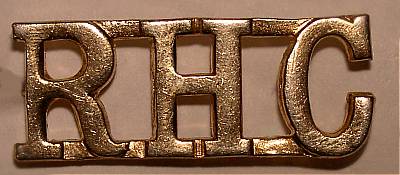
Metal Shoulder Titles were worn on prewar
Service Dress and sometimes continued to be worn on Battle Dress early in the war.
|
|
By 1943, the policy regarding security was
eased by the British, and Canada followed suit. Many British units had adopted
coloured shoulder "flashes", and these are evident during the fighting in France
in 1940, despite being against official policy. (Similar flashes had been worn in
the First World
War, often on the back of the tunic rather than the sleeves.) These
"flashes" differed from "titles" in that they were usually geometric
in nature, without printing, and the colour and shape alone identified the unit.
Canadian units never adopted similar flashes. |
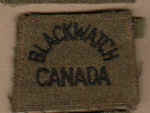
The "worsted title", or
slip-on, was the officially sanctioned form of Unit Insignia until midway through the war.
|
|
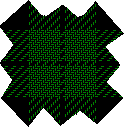
|
Examples of British "shoulder
flashes". The Government tartan patch cut into the shape of a star was worn by
the Black Watch (Royal Highland Regiment) while the inverted blue triangle was worn by the
Royal West Kents. While Scottish units seem to have retained the tartan shoulder
flashes for the duration of the Second World War, most regular infantry units adopted Unit Titles
with names or abbreviations on them. Canadian units did not adopt similar
"flashes". |
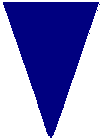
|
The need, or desire, for
unit identification was seen to outweigh the security risk this insignia caused, and the
British began to issue a wide variety of coloured cloth insignia for wear on Battle Dress,
designating both Formation and Unit. These badges took the form of
"titles", usually being a crescent shape (for units) with letters spelling out
the unit's name or abbreviated title. Formation patches are also a study unto
themselves, but usually consisted of an image that was related to the unit, and varied
from simple geometric shapes, to flora or fauna from the division's home counties, to
plays on words involving the commanding general's last name.
The British army orders for various types of
cloth distinguishing items were issued in 1940, 1941, 1943. In the 1943 ACI order, Unit
Titles were first officially authorized for widespread wear. Prior to that only guards
regiments and a few other units were officially permitted to wear cloth titles.
Canada, from 1939, had granted permission to only four units - the Governor
General's Foot Guards, the Canadian Grenadier Guards, PPCLI and the Canadian Provost Corps
- to wear cloth shoulder titles.
Canada allowed other units to wear cloth
shoulder titles and introduced Formation and Unit insignia of its own. The 2nd and
5th Divisions combined the two, for a time, and the formation patches also identified the
units in those divisions. Other divisions, while authorizing separate Unit and
Formation patches for the infantry, armoured and artillery units therein, issued combined
formation/unit patches to men of the supporting arms. By 1945, however, official
policy was to have "plain" formation patches for all arms and units, and even
the troops of the supporting arms (signals, service, medical, etc.) wore distinctive
lettered patches on the upper sleeves in addition to plain formation patches. These
patches could technically be likened to the Unit Titles worn by infantry battalions or
tank regiments, however they were not unit-specific and generic to the corps -
i.e. Royal
Canadian Ordnance Corps troops wore the same RCOC badges no matter which unit they
belonged to (be it No. 2 Infantry Workshop, No. 3 Mobile Bath and Laundry Unit, etc.
Completely specific Unit Titles were common only to infantry, armoured, and
artillery Units.
The variety of materials used to construct
these badges is a study in itself. While the Canadian Army followed the British in
terms of policies regarding the new badges, they did not follow the rules on details of
construction, materials or colours. While British shoulder titles for infantry
regiments, for example, were "supposed to be" in white letters on a scarlet
background (and many British infantry units ignored this restriction), Canadian regimental
shoulder titles were usually done in unit colours. While two rifle regiments adopted
titles consisting of red letters on a rifle green background, many more adopted wildly
varying designs and colours.
Canadian shoulder flashes were constructed in
Canada, but also produced locally wherever he was stationed - in the UK before D-Day, and
in Holland after VE Day. Canadian badges are identifiable by their "weave"
- the quality of the stitching. Different materials were used for backings,
including Melton and felt.
The British introduced
"canvas" badges during the war; these were cotton badges that were printed on,
rather than embroidered, and badges and patches of most Canadian units to serve in the UK
were also produced in this manner as well, beginning in about 1943. Canada
adoption of these badges was also owed to a lack of British manufacturing ability and the
increasing difficulty of obtaining Melton wool during a time of strict rationing. |
|
Examples of the different quality encountered in badges. At top is a printed
"canvas" title. Compare to the title at bottom, a British manufactured
cloth title. The crude embroidery and overall shape can be compared to the
Canadian-manufactured badge in the middle.
The replacement of crudely embroidered badges with the canvas
badges was a tradeoff, as the canvas badges tended to fade quickly and were not as
durable.
Artifacts and photo by
Bill Alexander. |

|
The end result was that there was no one
standard for badges; the "canvas" badges (as they are referred to today by
collectors) faded quickly (see below) and were not terribly well liked. Badges from
Canada featured smaller, neater embroidery compared to the broad "Aldershot"
weave of British badges. British-made badges tended to show a great variety of
quality and colour, also. There seems to have been little effort made to standardize
which badges could be worn and which could not.
The question of "when" the Canadians
started issuing their own distinctive cloth badges for Battle Dress is an interesting one. One 1942 Canadian Army Routine Order lists the slip-ons, and a few
"patches, Shoulder" for ten units appearing to be 3rd Division units, except the GGFG who had permission to wear such a title from 1939 on. Official orders, however
often came about after badges were already being worn for a long time, or vice versa an
example would be paperwork in the possession of Bill Alexander, detailing the acceptance
of canvas titles for the Perth Regiment, dated April 1944. The badges were not
actually worn until March 1945 at the earliest.
To add to the confusion, the Canadian Army had
two administrative divisions - the army at home, and the Canadian Army (Overseas), and
both had different regulations regarding insignia. While the "worsted" or
slip-on titles were officially supposed to be worn by 2nd (reserve) battalions in Canada,
they too eventually went over to Unit Titles. Clive Law (Service Publications) has
found this relevant item in the National Archives: When Military District 3 in
Canada asked units in their districts for proposals for Unit Titles the CO of the 2nd Bn
Midland Regiment replied:
1. Permission
is requested for the 2nd (R) Bn Midland Regt to wear the popular name of the Unit as a
shoulder Flash as described in the attached sketch.
2. The Unit esprit de corps is good and the Unit has a
good reputation so that it would be a privilege to wear the Flash.
3. As there is no privilege without a corresponding
obligation, it would be incumbent upon each member of the Unit to conduct himself in a
manner which will enhance the reputation of the Unit.
4. Re. the informality of the wording of the Flash, it
is requested that the Unit be permitted to express this measure of originality.

|
PRINTED INSIGNIA
Cotton printed badges, also known to collector's as
"canvas" badges, were introduced during the war as an economy measure.
These badges tended to quickly fade and were not as durable as the Melton badges.
Compare the unissued canvas titles at left with the example at right. The Division
patch is also in "canvas." |

|
Bill Alexander adds the following:
There are several types of construction used in cloth
flashes. Titles with backing materials are both Canadian made and British made. However
there are titles made on felt with no backing, and which appears to have a glue substance
or residue on them. In collecting circles these are sometimes know as glue-backs (very
inventive). They are also a British manufacture only. These were made for all the Canadian
units which drew on the British supply system in WWII. Thus you will not find the
glue-backs for units which only served in Canada.
Canvas is the same. Canvas was an economy measure title
only made in UK for troops in the supply line there. Thus you will find a canvas Vet's
Guard because they sent a company for protective duties over-seas. As well, the 13 Brigade
units made it to Britain and had patches made before they were disbanded and used as
re-enforcements. These are also somewhat scarce compared to other units. Brooker goes to
some length to suggest that there are early manufacture and late manufacture. There are
certainly different types of canvas titles but I don't know how to clearly identify which
was made when. I have seen canvas with a buff backing material and the more common black
linen type material.
The ordnance issue of printed patches and flashes was
consistent with British Army practice. The first issue was made in 1943, and the final
issue was made in 1945. There were no Canadian system issues of the printed flash in the
post war era.
The patches and flashes which were produced were only for
those Canadian units and formations that were posted to the United Kingdom at some point.
For example, all CASF units that were posted to the UK had a canvas flash produced. This
included the Veterans Guard and components of the 13 Inf Bde that had been in Kiska and
were then transferred to Britain. (The Veterans Guard were sent to release trained soldiers
from certain duties, which made the younger soldiers available for active service.)
Units which did not have a canvas title include:
|
Argyll
Light Inf (Tank) |
Brockville Rifles |
Les Fusiliers de Sherbrooke |
|
Les Fusiliers du St Laurent |
Garrison Battalions |
Grey and Simcoe Foresters |
|
Halifax Rifles |
Irish Fusiliers of Canada |
Kent Regiment |
|
King's Own Rifles of Canada |
Manitoba Mounted Rifles |
Manitoba Volunteer Reserve |
|
Middlesex and Huron Regiment |
Midland Regiment |
New Brunswick Regt (Tank) |
|
19th Alberta Dragoons |
Oxford Rifles |
Pacific Coast Milita Rangers |
|
Pictou Highlanders |
Prince Albert and Battleford
Volunteers |
Prince of Wales Rangers |
|
Prince Rupert Regiment |
Princess of Wales Own Regiment |
Queen's York Rangers |
|
Regt de Chateauguay |
Regt de Gaspe Bonaventure |
Regt de Joliette |
|
Regt de Levis |
Regt de Montmagny |
Regt de Quebec |
|
Regt de St Hyacinthe |
Regt de Saguenay |
Royal Canadian Army Veterinary
Corps |
|
Royal Rifles of Canada |
St. John Fusiliers |
Sault Ste Marie and Sudbury
Regiment |
|
Scots Fusiliers of Canada |
2nd Armoured Car Regiment |
2nd/10th Dragoons |
|
16th/22nd Saskatchewan Horse |
Victoria Rifles of Canada |
Voltigeurs de Quebec |
|
Winnipeg Light Infantry |
Also the Canadian
Forestry Corps, though no embroidered shoulder title was worn either. Instead, the
formation patch was worn as both a unit and a corps identifier; canvas versions of this
patch did exist. |
Among units to serve extensively in Europe, the following did
not have printed flashes: Canadian Intelligence Corps, 1st Canadian Armoured Carrier
Regt, and Canadian Army Women's Corps, The Dufferin and Haldimand Rifles, Edmonton Fusiliers,
Essex Regt (Tank), 15th Alberta Light Horse, 1st Special Service Force, 14th Canadian
Light Horse/Hussars (served as VIII Recce Regt, which did have a canvas flash).
Should one find any of the above in canvas they should be
treated with great suspicion. Several years ago bogus canvas flashes and formation patches
appeared on the market. These included some of the French Canadian regiments and others
such as 56 Recce. (The latter was a Canadian contingent sent to the mid-east in 1956 to
act as peacekeepers.) There were also bogus formation patches made up.
There are at least two exceptions to the rule. One is the
Kiska force patch, found in a form of printed title. It is quite different in material and
production than the UK printed material. The other exception is the Canadian Technical
Training Corps, which has authentic printed titles.
As to production, the Canadian printed flashes and patches
were silk screened on a cotton material. Different weights of cotton, both facing and
backing are found. The first issue, generally speaking, tends to be of a heavier
construction than the latter issue. Backing is usually black in colour but is also found
in khaki. I don't know much about ink or types of ink used. Printed flashes were not
durable and quickly deteriorated in the elements. Sun and water bleached them out. Most
soldiers preferred the melton title for best battledress.
Webmaster's note: Another
interesting variant pointed out by Bill Alexander and Ed Storey was the "BeVo"
style flash locally made in Belgium or Holland for the 1st Canadian Armoured Carrier
Regiment. BeVo is a term used by collectors to refer to a style of silk embroidery
common in German badges. The name itself comes from the BeVo-Wuppertal firm
(though they were not the only firm to produce this type of embroidery during
the Second World War, the
name has stuck among collectors.) Be stands for Beteilingung, or
"partnership" in English, Vo is short for Vorsteher. The firm
BeVo-Wuppertal came into being when the firms of Lucas Vorsteher and Ewelda Vorsteher
amalgamated; both came from the Wuppertal-Bermen area.
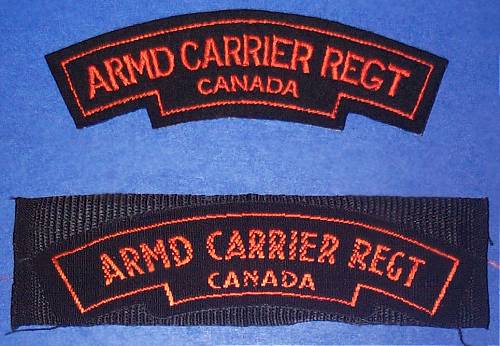
Artifacts and photo courtesy Ed
Storey
Bill Alexander on print runs:
I don't know of specifics on the numbers produced, but I do know
that the RCOC were aware of war establishments and numbers of personnel in various corps
and regiments. There was a scale of issue per man and this would be multiplied by some
number based upon war establishments, plus an anticipated attrition rate, to arrive at the
number produced. It is obvious that small units like Film and Photo Unit or Canadian
Chaplain Service didn't have the same needs and thus, smaller runs. The apparent scarcity
of other regimental titles like Le Regiment de Hull, may be explained by the fact that
they may have only had one run of titles. The Kiska units apparently arrived in the UK
well after the first printed titles were issued, and then were broken up for
reinforcements. They probably had far fewer made than other units, perhaps only one batch.
Another issue is the silk screen process. Screening
produces the crisp printed titles, but the screens wore out. Some variations in titles may
be explained by the need for new screens. Changes in official designations would also
require the change in screens and a new run. The 49th /Edmonton Regt vs 49th/ The Loyal
Edmonton Regt , the different Royal Montreal Regt MG and no MG and Cameron Highlanders of
Ottawa MG and no MG are good examples.
Finally in reference to ink, a collector can find
significant variations in shades of yellows (in particular) and other colours that appear
to be original printings, but different batches. Other differences in tone may be fading.
Printed titles, exposed to light, change very quickly. Sometimes these are presented as
"run variations", but are not.
Notes
Information on this page supplied in large part
by Bill Alexander, Chris Brooker, Dwayne Hordij, and Clive Law (Service Publications). |